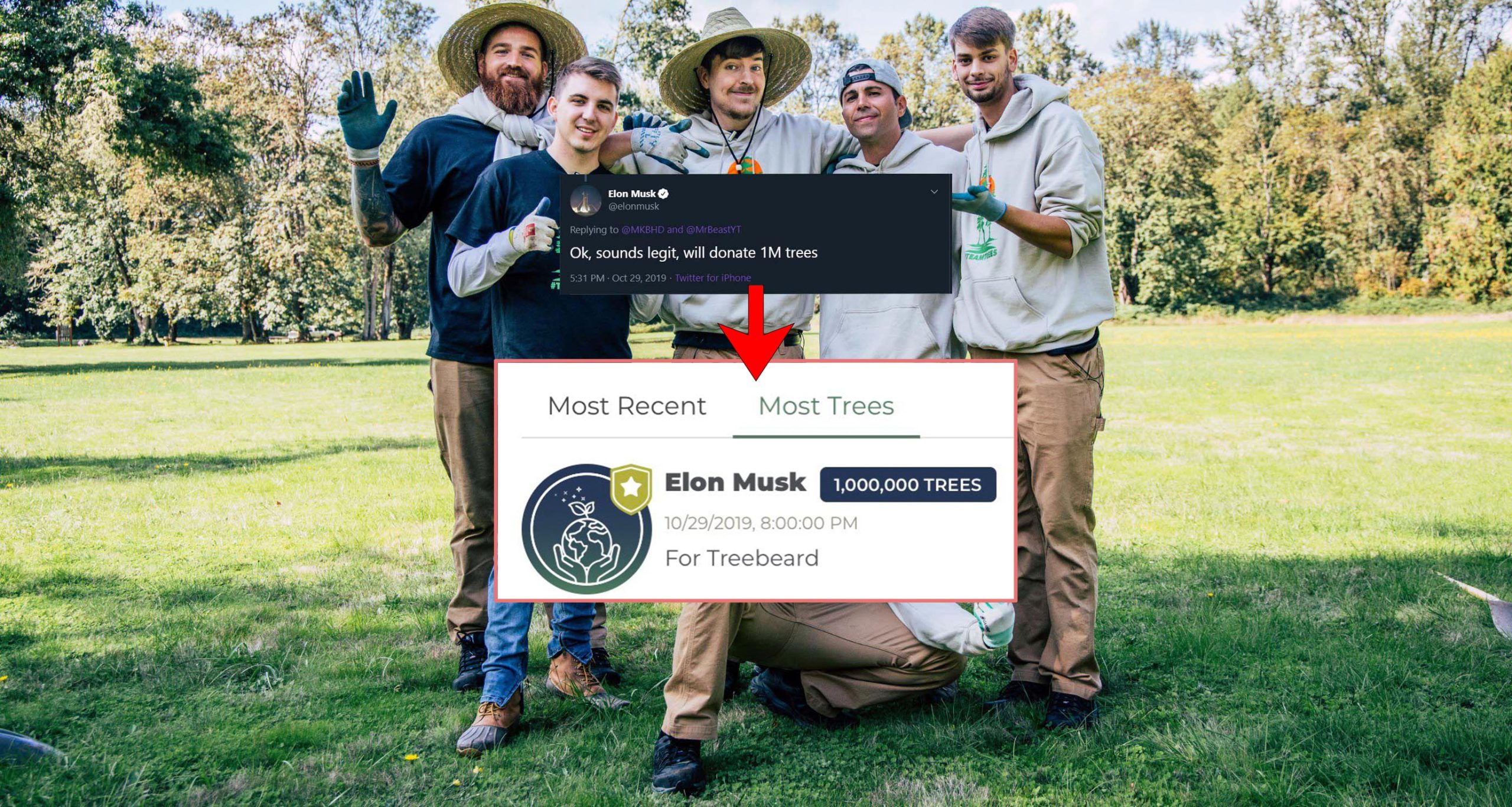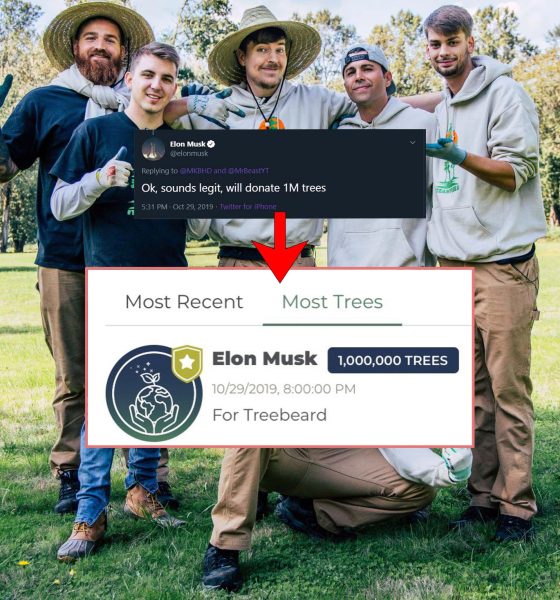

News
Elon Musk pledges $1 million to #TeamTrees viral tree-planting initiative
In May of 2019, popular YouTube creator “MrBeast” – real name: Jimmy Donaldson – reached 20 million subscribers. His followers quickly challenged him to plant as many trees as he had followers. In response, the YouTuber did what YouTubers do best: formed a collaborative effort of other well known YouTubers and legitimate foundations to crowdfund a viral challenge. The viral challenge has been so successful in just four days that it now has the backing of Tesla and SpaceX CEO Elon Musk.
Sounds cool. Where are the trees being planted & what kind of trees?— Elon Musk (@elonmusk) October 28, 2019
With the help of multiple partners, Donaldson paired up with The Arbor Day Foundation to create a fundraising campaign that would plant 20 million trees. TeamTrees.org was created and went live on Oct. 25th following an announcement video posted to the MrBeast Youtube channel. As stated on the site’s FAQ page, the organizers have promised all donors that “for every dollar you donate, one tree will be planted in a forest of high need around the world.”
In just four days the TeamTrees.org official Twitter account has garnered nearly 12 thousand followers when the challenge first caught the eye of Musk. Donaldson posted an update that “almost 6 million” trees had been planted accompanied by a screencap of what just 5,000 trees appeared as in the popular online game “Fortnite.” Musk responded “sounds cool,” but wanted more information and asked, “where are the trees being planted & what kind of trees?”
Of course, it comes as no surprise that the prospect of planting 20 million trees piqued the interest of the billionaire that founded Tesla. Musk has long been a supporter of the premise that electric vehicles could help reduce emissions and preserve the earth of the future. Combining an initiative to save Mother Earth by planting trees and using Fortnite as a visual reference was as genius as it could get to guarantee to grab the billionaire’s attention.
The factor that really drove it home was an almost immediate response by the influential tech review Youtuber, Marques Brownlee. Brownlee, who has had the opportunity to interview Musk at a Tesla factory, responded by linking the billionaire directly to the TeamTrees.org website. Musk then, almost as immediately, pledged to “donate 1M trees,” in other words, donate $1 million to the cause.
Ok, sounds legit, will donate 1M trees— Elon Musk (@elonmusk) October 29, 2019
Musk’s promised donation quickly gained appreciation all over the internet. The official Youtube Twitter account soon confirmed the legitimacy of Musk’s pledge. Then, larger than life social media platform – owned by parent company Google – promised to match every one of the following million donations to keep the support of TeamTrees.org going.
While pledging to plant 20 million trees is surely an effort in the right direction of combating global climate change, it may be just a drop in a bucket. As suggested in a fortuitous and completely unrelated article, WIRED.com suggests that more than just planting trees would need to be done in order to really address the issue of excess carbon in the atmosphere. An overarching theme of the article is that “seedlings and fancy agriculture” won’t even make a dent in the issue if emissions aren’t reduced.
“It’s possible to imagine agriculture as a kind of geoengineering, of improving on nature’s yields and productivity. If it could also improve on nature’s ability to put carbon in the ground, that would be transformative. But there’s no evidence yet people can do it at a scale that it can by itself save the planet.” – WIRED.com
Perhaps it won’t completely save the planet from the destruction that has already been done but surely vowing to plant sustainable trees in forests of high need is a step in the right direction. Especially when the cause has gained the attention of thousands of internet users and some very influential creators including MythBusters’ Adam Savage and SmarterEveryday’s Destin Sandlin.
If you would like more information about the campaign backed by Elon Musk, you can view the announcement video below or visit TeamTrees.org to pledge your own donation.

News
Tesla FSD fleet is nearing 7 billion total miles, including 2.5 billion city miles
As can be seen on Tesla’s official FSD webpage, vehicles equipped with the system have now navigated over 6.99 billion miles.

Tesla’s Full Self-Driving (Supervised) fleet is closing in on almost 7 billion total miles driven, as per data posted by the company on its official FSD webpage.
These figures hint at the massive scale of data fueling Tesla’s rapid FSD improvements, which have been quite notable as of late.
FSD mileage milestones
As can be seen on Tesla’s official FSD webpage, vehicles equipped with the system have now navigated over 6.99 billion miles. Tesla owner and avid FSD tester Whole Mars Catalog also shared a screenshot indicating that from the nearly 7 billion miles traveled by the FSD fleet, more than 2.5 billion miles were driven inside cities.
City miles are particularly valuable for complex urban scenarios like unprotected turns, pedestrian interactions, and traffic lights. This is also the difference-maker for FSD, as only complex solutions, such as Waymo’s self-driving taxis, operate similarly on inner-city streets. And even then, incidents such as the San Francisco blackouts have proven challenging for sensor-rich vehicles like Waymos.
Tesla’s data edge
Tesla has a number of advantages in the autonomous vehicle sector, one of which is the size of its fleet and the number of vehicles training FSD on real-world roads. Tesla’s nearly 7 billion FSD miles then allow the company to roll out updates that make its vehicles behave like they are being driven by experienced drivers, even if they are operating on their own.
So notable are Tesla’s improvements to FSD that NVIDIA Director of Robotics Jim Fan, after experiencing FSD v14, noted that the system is the first AI that passes what he described as a “Physical Turing Test.”
“Despite knowing exactly how robot learning works, I still find it magical watching the steering wheel turn by itself. First it feels surreal, next it becomes routine. Then, like the smartphone, taking it away actively hurts. This is how humanity gets rewired and glued to god-like technologies,” Fan wrote in a post on X.
News
Tesla starts showing how FSD will change lives in Europe
Local officials tested the system on narrow country roads and were impressed by FSD’s smooth, human-like driving, with some calling the service a game-changer for everyday life in areas that are far from urban centers.

Tesla has launched Europe’s first public shuttle service using Full Self-Driving (Supervised) in the rural Eifelkreis Bitburg-Prüm region of Germany, demonstrating how the technology can restore independence and mobility for people who struggle with limited transport options.
Local officials tested the system on narrow country roads and were impressed by FSD’s smooth, human-like driving, with some calling the service a game-changer for everyday life in areas that are far from urban centers.
Officials see real impact on rural residents
Arzfeld Mayor Johannes Kuhl and District Administrator Andreas Kruppert personally tested the Tesla shuttle service. This allowed them to see just how well FSD navigated winding lanes and rural roads confidently. Kruppert said, “Autonomous driving sounds like science fiction to many, but we simply see here that it works totally well in rural regions too.” Kuhl, for his part, also noted that FSD “feels like a very experienced driver.”
The pilot complements the area’s “Citizen Bus” program, which provides on-demand rides for elderly residents who can no longer drive themselves. Tesla Europe shared a video of a demonstration of the service, highlighting how FSD gives people their freedom back, even in places where public transport is not as prevalent.
What the Ministry for Economic Affairs and Transport says
Rhineland-Palatinate’s Minister Daniela Schmitt supported the project, praising the collaboration that made this “first of its kind in Europe” possible. As per the ministry, the rural rollout for the service shows FSD’s potential beyond major cities, and it delivers tangible benefits like grocery runs, doctor visits, and social connections for isolated residents.
“Reliable and flexible mobility is especially vital in rural areas. With the launch of a shuttle service using self-driving vehicles (FSD supervised) by Tesla in the Eifelkreis Bitburg-Prüm, an innovative pilot project is now getting underway that complements local community bus services. It is the first project of its kind in Europe.
“The result is a real gain for rural mobility: greater accessibility, more flexibility and tangible benefits for everyday life. A strong signal for innovation, cooperation and future-oriented mobility beyond urban centers,” the ministry wrote in a LinkedIn post.
News
Tesla China quietly posts Robotaxi-related job listing
Tesla China is currently seeking a Low Voltage Electrical Engineer to work on circuit board design for the company’s autonomous vehicles.

Tesla has posted a new job listing in Shanghai explicitly tied to its Robotaxi program, fueling speculation that the company is preparing to launch its dedicated autonomous ride-hailing service in China.
As noted in the listing, Tesla China is currently seeking a Low Voltage Electrical Engineer to work on circuit board design for the company’s autonomous vehicles.
Robotaxi-specific role
The listing, which was shared on social media platform X by industry watcher @tslaming, suggested that Tesla China is looking to fill the role urgently. The job listing itself specifically mentions that the person hired for the role will be working on the Low Voltage Hardware team, which would design the circuit boards that would serve as the nervous system of the Robotaxi.
Key tasks for the role, as indicated in the job listing, include collaboration with PCB layout, firmware, mechanical, program management, and validation teams, among other responsibilities. The role is based in Shanghai.
China Robotaxi launch
China represents a massive potential market for robotaxis, with its dense urban centers and supportive policies in select cities. Tesla has limited permission to roll out FSD in the country, though despite this, its vehicles have been hailed as among the best in the market when it comes to autonomous features. So far, at least, it appears that China supports Tesla’s FSD and Robotaxi rollout.
This was hinted at in November, when Tesla brought the Cybercab to the 8th China International Import Expo (CIIE) in Shanghai, marking the first time that the autonomous two-seater was brought to the Asia-Pacific region. The vehicle, despite not having a release date in China, received a significant amount of interest among the event’s attendees.








